 The are many reasons why our dogs and cats get itchy! But when they do, they are miserable! To alleviate the itch, they scratch and lick and scratch and lick the skin some more, over and over and over again. This constant licking can result in…summer sores, acute moist dermatitis, lick granulomas, acral lick dermatitis, OCLD (obsessive compulsive licking disorder). A hot spot by any name is still a painful nuisance to your furry best friend and is often difficult to heal. Lick sores seem to appear spontaneously, and for some reason are less common in cats, yet they can occur and are generally found in easier-to-reach locations where a pet licks a small irritation and creates a flare up.
The are many reasons why our dogs and cats get itchy! But when they do, they are miserable! To alleviate the itch, they scratch and lick and scratch and lick the skin some more, over and over and over again. This constant licking can result in…summer sores, acute moist dermatitis, lick granulomas, acral lick dermatitis, OCLD (obsessive compulsive licking disorder). A hot spot by any name is still a painful nuisance to your furry best friend and is often difficult to heal. Lick sores seem to appear spontaneously, and for some reason are less common in cats, yet they can occur and are generally found in easier-to-reach locations where a pet licks a small irritation and creates a flare up.
Veterinarians often cannot prescribe a specific cure since way down to the base layer of the skin, microscopic pockets of bacteria and any combination of broken hair follicles, plugged and scarred oil glands and dilated and inflamed capillaries are present. If surgically removed, the pet then licks at the sutures or incision line creating a brand new granuloma, and the cycle repeats.
What Causes Hot Spots?
Hot spots occur when an animal itches, scratches and licks himself excessively forming a wet opening on the skin – often after a flea bites! Normal healthy bacteria are always present on an animal’s body, but once he bites or chews and breaks the skin’s surface, if there is even a little moisture, the perfect environment for bacterial contamination exists! Hot spots often form on the top of a dog’s wrist joint or one of his paws – easy to lick spots – but can also be found on the hind legs and even ear flaps, especially in breeds with floppy ears. Affected pets generally have an allergic reaction, irritation or other underlying skin condition that starts them on an itch-lick-chew cycle. Some however, chew and lick purely out of boredom or as self-stimulation to alleviate separation anxiety. The pet becomes fixated and compulsively licks until a wound develops.
How to Prevent Itchy Skin
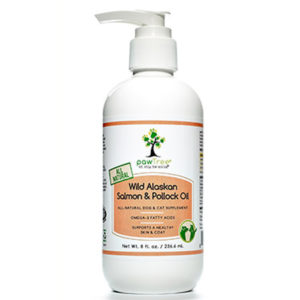
Lick sores occur more frequently during humid weather, after a bath or swim or when an animal walks in the rain, so it is imperative to keep pets clean, well-groomed and parasite-free. Pay attention to the smallest of sores, as even a slighting oozing wound can provide enough moisture for the bacteria to take hold. Irritation from matted fur can also cause these bothersome lesions to develop in any breed but particularly in those with dense undercoats. Feeding your dog or cat WILD ALASKAN SALMON & POLLOCK OIL on a daily basis just might contribute to your dog or cat’s overall health, and result in a healthy skin and coat that does not itch!
- EPA and DHA in this oil (and the chewable drops) have been proven to help prevent skin allergies
- Help to reduce inflammation
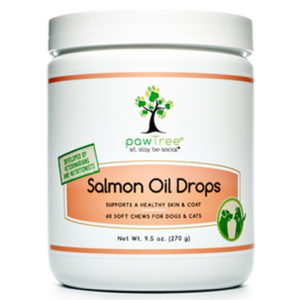
https://pawtree.com/thepetsafetycrusader/product/2459 - Promotes an optimally-functioning immune system
- Supports a healthy skin & coat (making it soft and shiny)
This nutrient-rich Wild Alaskan Salmon & Pollock Oil contains over 15 heart-healthy Omega-3 and Omega-6 Fatty Acids that are good for other body parts too!
Signs & Symptoms of Hot Spots, Lick Sores, Itches & Twitches
- Compulsive licking and chewing at a particular body part
- Raised, rough, raw-looking lesion, typically on the top of a lower front leg or paw (but can be anywhere the pet can reach to lick or scratch)
- Reddish-brown saliva staining around the hot spot site
- Oozing, ulcerated, pus-filled drainage tracts coming from the hot spot site
- Foul smell coming from the hot spot site
- Swelling around the hot spot site
- Pain and visible discomfort
How to Relieve the Itch?
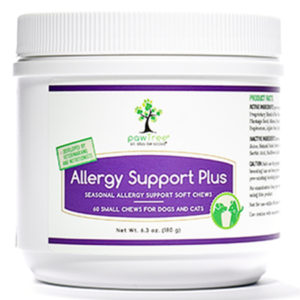
Allergies too can cause a pet to lick and scratch so providing allergy support, may prevent the itch and therefore…the scratch! An allergy is a hypersensitive reaction to a pollen, food, something inhaled or that touches the skin. ALLERGY SUPPORT PLUS contains the highest quality herbs known to support the body’s normal ability to combat skin-related issues associated with food and seasonal allergies. This highly effective product will relieve the itch and calm the skin so your pet can be comfortable. ALLERGY SUPPORT PLUS:
- Balances the excesses and deficiencies in the body
- Helps to reduce heat in the body and drains phlegm
- Unlike chalky tablets and pills, these chews are so tasty your dog or cat will LOVE them!
- Developed by Veterinarians and Nutritionists and made in the U.S.A.
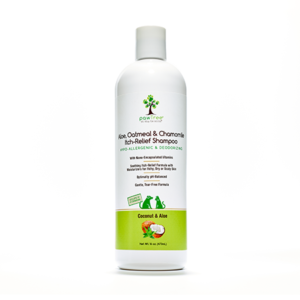
Pet parents aren’t happy when our fur kids are uncomfortable, so when your dog or cat has skin issues, a moisturizing bath might relieve the problems. ALOE, OATMEAL & CHAMOMILE ITCH-RELIEF SHAMPOO is a soothing formula that provides relief from itchy, dry, flaky and sensitive skin. Specially formulated for dogs and cats, this gentle, hypo-allergenic formula is soap free so it won’t dry out your pet’s skin and will not wash away flea & tick preventative topicals. It contains aloe and oat extracts, nourishing natural oils and vitamins A, D and E to help soothe and repair irritated skin, as well as restore natural moisture to your pet’s skin and keep their coat healthy. Your pet will be feeling soft, refreshed and itch-free!
What to Do if More than Simple Itchies, Maybe a Hot Spot or Lick Sore
According to Julie Buzby, DVM, CVA, CAVCA and Founder of Dr. Buzby’s Innovations, “Early intervention is key for hotspots…and although home remedies may work, hot spots can grow quickly and are uncomfortable for your pet, so I always recommend veterinary treatment. Lick sores are usually secondary to something else, such as atopy (seasonal allergies), flea allergies or even pain, so in addition to addressing the immediate need of the wound, a longer term strategy might be needed to prevent this from becoming a seasonal or recurring issue. In other words, don’t be surprised if your veterinarian talks about a bigger picture than just the oozy sore that you made the appointment for. Although there are various types of hot spot-causing bacteria, most respond to oral and topical antibiotics.” Buzby continues, “Successful treatment will usually require figuring out the root cause. There is no miracle cure for lick granulomas, but acupuncture can sometimes be a valuable part of treatment and I’ve personally seen success with this in a few patients.”
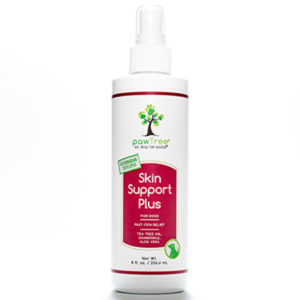
Before Veterinary Care is Available
- Trim fur around the hot spot with blunt nosed scissors. Exposing it to air will help dry out the moisture and speed healing.
- Clean area with a well-diluted mixture of chlorhexidine and water (Hibiclens) and pat dry.
- Spray SKIN SUPPORT PLUS directly on raw, irritated skin 1 – 4X daily, avoiding eyes. It contains Tea Tree Oil – an effective natural remedy for rashes, blisters, sunburns, insect bites and other minor irritations; Aloe Vera – soothes, moisturizes and cools irritated skin while reducing inflammation and pain; Chamomile – contains antiseptic, anti-inflammatory and sedative properties.
- Do not apply ointments to a hot spot as these products seal in infection while medications containing alcohol will burn an open wound. If you’re awaiting your SKIN SUPPORT PLUS to arrive, apply a tea bag (green, not herbal, that has cooled after being soaked for 5 minutes in hot water). The tannic acid is a natural astringent that dries and heals. Use this treatment 3-5 times per day until healed or get to your veterinarian in a couple days if it is not!
Work with your veterinarian to zero-in on the underlying cause of your pet’s itch: fleas, pollen, food, cleaning products, stress or whatever the source…eliminate it! Many veterinarians prescribe cortisone, an anti-inflammatory steroid, to stop the itch-scratch cycle and antibiotics to fight the infection. Unfortunately, steroids can have serious side effects over extended periods of time while many other topical sprays contain alcohol, lidocaine, hydrocortisone, or other harsh chemical ingredients that can damage, burn or dry out your pet’s skin.









